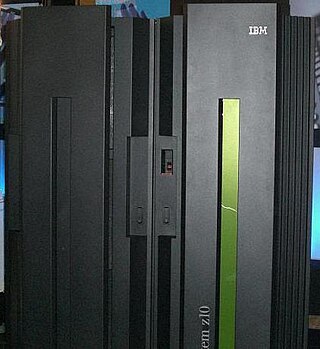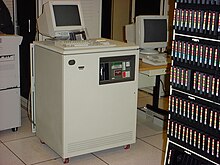IBM mainframes are large computer systems produced by IBM since 1952. During the 1960s and 1970s, IBM dominated the computer market with the 7000 series and the later System/360, followed by the System/370. Current mainframe computers in IBM's line of business computers are developments of the basic design of the System/360.

A mainframe computer, informally called a mainframe or big iron, is a computer used primarily by large organizations for critical applications like bulk data processing for tasks such as censuses, industry and consumer statistics, enterprise resource planning, and large-scale transaction processing. A mainframe computer is large but not as large as a supercomputer and has more processing power than some other classes of computers, such as minicomputers, servers, workstations, and personal computers. Most large-scale computer-system architectures were established in the 1960s, but they continue to evolve. Mainframe computers are often used as servers.

Transaction Processing Facility (TPF) is an IBM real-time operating system for mainframe computers descended from the IBM System/360 family, including zSeries and System z9.

VSEn is an operating system for IBM mainframe computers, the latest one in the DOS/360 lineage, which originated in 1965. It is less common than z/OS and is mostly used on smaller machines.

z/OS is a 64-bit operating system for IBM z/Architecture mainframes, introduced by IBM in October 2000. It derives from and is the successor to OS/390, which in turn was preceded by a string of MVS versions. Like OS/390, z/OS combines a number of formerly separate, related products, some of which are still optional. z/OS has the attributes of modern operating systems but also retains much of the older functionality that originated in the 1960s and is still in regular use—z/OS is designed for backward compatibility.

Hercules is a computer emulator allowing software written for IBM mainframe computers and for plug compatible mainframes to run on other types of computer hardware, notably on low-cost personal computers. Development started in 1999 by Roger Bowler, a mainframe systems programmer.
Systems Network Architecture (SNA) is IBM's proprietary networking architecture, created in 1974. It is a complete protocol stack for interconnecting computers and their resources. SNA describes formats and protocols but, in itself, is not a piece of software. The implementation of SNA takes the form of various communications packages, most notably Virtual Telecommunications Access Method (VTAM), the mainframe software package for SNA communications.

VM is a family of IBM virtual machine operating systems used on IBM mainframes System/370, System/390, zSeries, System z and compatible systems, including the Hercules emulator for personal computers.

Amdahl Corporation was an information technology company which specialized in IBM mainframe-compatible computer products, some of which were regarded as supercomputers competing with those from Cray Research. Founded in 1970 by Gene Amdahl, a former IBM computer engineer best known as chief architect of System/360, it has been a wholly owned subsidiary of Fujitsu since 1997. The company was located in Sunnyvale, California.
Virtual Telecommunications Access Method (VTAM) is the IBM subsystem that implements Systems Network Architecture (SNA) for mainframe environments. VTAM provides an application programming interface (API) for communication applications, and controls communication equipment such as adapters and controllers. In modern terminology, VTAM provides a communication stack and device drivers.
The Integrated Facility for Linux (IFL) is an IBM mainframe and Power Systems processor dedicated to running the Linux operating system. On IBM Z and IBM LinuxONE machines, IFLs can be used with or without hypervisors such as z/VM and KVM. IFLs are one of three most common types of "specialty" IBM mainframe processors that give software vendors more granular control over software licensing and maintenance costs.. Microcode restricts IFLs to Linux workload by omitting some processor instructions not used by the Linux kernel, but the underlying processors are physically identical to general purpose processors (CPs). When IBM adds features and performance improvements to its mainframes' general purpose main processors, those features and improvements nearly always apply equally to IFLs. In fact, in recent IBM Z machines IFLs support simultaneous multithreading, a feature not available for general purpose processors.
In computing, a Parallel Sysplex is a cluster of IBM mainframes acting together as a single system image with z/OS. Used for disaster recovery, Parallel Sysplex combines data sharing and parallel computing to allow a cluster of up to 32 systems to share a workload for high performance and high availability.

A front-end processor (FEP), or a communications processor, is a small-sized computer which interfaces to the host computer, a number of networks, such as SNA, or a number of peripheral devices, such as terminals, disk units, printers and tape units. Data is transferred between the host computer and the front-end processor using a high-speed parallel interface. The front-end processor communicates with peripheral devices using slower serial interfaces, usually also through communication networks. The purpose is to off-load from the host computer the work of managing the peripheral devices, transmitting and receiving messages, packet assembly and disassembly, error detection, and error correction. Two examples are the IBM 3705 Communications Controller and the Burroughs Data Communications Processor.

The IBM 3705 Communications Controller is a simple computer which attaches to an IBM System/360 or System/370. Its purpose is to connect communication lines to the mainframe channel. It was a first communications controller of the popular IBM 37xx series. It was announced in March 1972. Designed for semiconductor memory which was not ready at the time of announcement, the 3705-I had to use 1.2 microsecond core storage; the later 3705-II uses 1.0 microsecond SRAM. Solid Logic Technology components, similar to those in S/370, were used.

IBM Z is a family name used by IBM for all of its z/Architecture mainframe computers. In July 2017, with another generation of products, the official family was changed to IBM Z from IBM z Systems; the IBM Z family now includes the newest model, the IBM z16, as well as the z15, the z14, and the z13, the IBM zEnterprise models, the IBM System z10 models, the IBM System z9 models and IBM eServer zSeries models.

IBM 37xx is a family of IBM Systems Network Architecture (SNA) programmable communications controllers used mainly in mainframe environments.
The IBM Network Control Program, or NCP, was software that ran on a 37xx communications controller and managed communication with remote devices. NCP provided services comparable to the data link layer and Network Layer functions in the OSI model of a Wide area network.

IBM System z10 is a line of IBM mainframes. The z10 Enterprise Class (EC) was announced on February 26, 2008. On October 21, 2008, IBM announced the z10 Business Class (BC), a scaled-down version of the z10 EC. The System z10 represents the first model family powered by the z10 quad core processing engine. Its successors are the zEnterprise System models introduced in 2010 and 2012.
Linux on IBM Z or Linux on zSystems is the collective term for the Linux operating system compiled to run on IBM mainframes, especially IBM Z / IBM zSystems and IBM LinuxONE servers. Similar terms which imply the same meaning are Linux/390, Linux/390x, etc. The three Linux distributions certified for usage on the IBM Z hardware platform are Red Hat Enterprise Linux, SUSE Linux Enterprise Server, and Ubuntu.
Communications Controller for Linux is an IBM software product announced in 2005 that runs under Linux on IBM Z and emulates an IBM 37xx communications controller. CCL runs unmodified IBM Network Control Program (NCP) to allow consolidation of an SNA network infrastructure to IP. According to IBM "SNA traffic enters and leaves CCL as SNA network flows over an OSA adapter. However, your wide area network infrastructure does not need to be SNA. You can consolidate your SNA traffic and use tunneling such as data link switching (DLSw) to encapsulate the SNA communication over an IP network."











